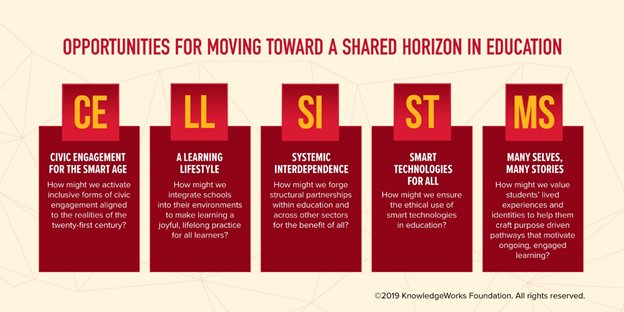Editor’s note: This is part one in a three-part series.
Between the breakneck speed of technology’s advance and tectonic shifts in the job market, educators and learners can feel overwhelmed.
But these and other changes are upon us and are likely to accelerate. That’s why KnowledgeWorks, a national education nonprofit, has followed up its latest 10-year education forecast with a strategy guide that helps frame the challenges and opportunities facing our education system and how educators, learners and policymakers can begin to meet them.
The next decade represents an opportunity to imagine new kinds of education structures, practices and programs that support the healthy development of young people, enable lifelong learning and drive community vitality.
My colleagues and I on KnowledgeWorks’ strategic foresight team formed the strategy guide with the help of two workshops. More than 70 stakeholders, including teachers, administrators, students and thought leaders, convened to explore what KnowledgeWorks’ latest 10-year forecast, Navigating the Future of Learning, could mean for their organizations and others like them. Their insights were essential to making the guide more grounded, more practical, and more representative of the diverse field that is education than it would have been had our team authored the guide based solely on what we saw.
Five opportunities

The strategy guide distills mountains of input into five opportunity areas for moving toward a more human-centered, equitable future of learning:
- Civic Engagement for the Smart Age: How might we activate inclusive forms of civic engagement aligned to the realities of the 21st Century?
- A learning lifestyle: How might we integrate schools into their environments to make learning a joyful, lifelong practice for all learners?
- Systemic interdependence: How might we forge structural partnerships within education and across other sectors for the benefit of all?
- Smart technologies for all: How might we ensure the ethical use of smart technologies in education?
- Many selves, many stories: How might we value students’ lived experiences and identities to help them craft purpose-driven pathways that motivate ongoing, engaged learning?
From that high-level frame, the guide delves deeper to offer three examples of strategies that stakeholders might adopt for each of the five opportunity areas. It also offers more specific tactics related to each strategy.
Finally, in the “Taking Action Now” section, seven questions encourage stakeholders to put the guide to use, starting with asking, “What is your vision for the future of learning?”
How to use the guide
I recommend starting with those questions, either individually or with colleagues, to begin exploring what the future possibilities and strategic guidance in the publication could mean for a specific context and how the people in that context might want to respond. Another starting point could be picking one dimension of the guide that resonates, then reviewing one’s organization’s strategy and operations in light of the associated strategies and tactics.
The guide can be used largely on its own or in the context of a broader exploration of the future of learning anchored in the core forecast upon which it builds.
Why it’s important
The strategy guide is no mere intellectual exercise. As our 10-year forecast identifies, students, the future workforce and society as a whole face rapid changes. How educators and policymakers respond to those changes may determine whether persistent achievement gaps are exacerbated or narrowed.
Likely changes include:
- The availability of smart technologies could either subsume personal agency or complement learning.
- As public institutions struggle to adapt to change, young people could become vocal agents of change or silent passengers.
- Amid unprecedent streams of information buffeting learners, future learners may struggle to foster empathy, confront ambiguity and pause for self-reflection.
- New waves of migration, changing labor structures and environmental volatility will all affect our communities.
Such changes represent both threats and opportunities. If stakeholders elect to ignore them, they will risk widening the equity gap, leaving too many learners unprepared and undermining learners’ agency. But if education stakeholders take hold of emerging trends, they could cultivate their institutions to be tomorrow’s innovators.
KnowledgeWorks’ strategic foresight team is accepting invitations to present on the guide in person or to create custom workshops that help organizations and groups apply the guide in their context. We are available to write guest blog posts and articles and to participate in podcasts and other interviews or to facilitate workshops exploring opportunities to shape the future of learning.
About the Author
Katherine Prince leads KnowledgeWorks’ exploration of the future of learning. As Vice President, Strategic Foresight, she speaks and writes about the trends shaping education over the next decade and helps education stakeholders strategize about how to become active agents of change in shaping the future. For more on the opportunities described in this post, see KnowledgeWorks’ Navigating the Future of Learning: A Strategy Guide. She tweets as @katprince and invites you to watch for the hashtags #NavigateFutureEd and #FutureEd.











